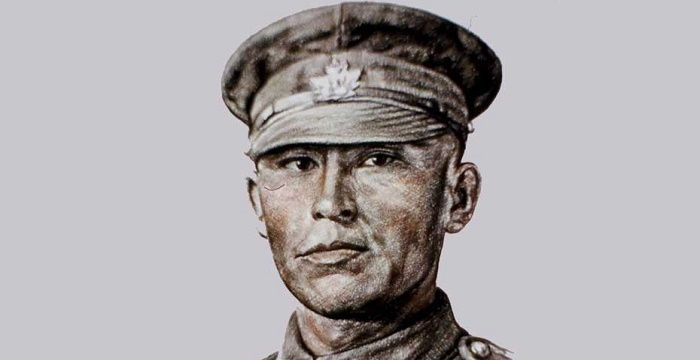One of the most successful snipers in history: Who is Francis Pegahmagabow?
A native of Canada, Francis was one of the most effective snipers of the First World War.

Francis Pegahmagabow is recognized as one of the most successful snipers in history. Pegahmagabow, who lived from 1891 to 1952; is a soldier, and politician, but also has an activist identity.
A native of Canada, Francis was one of the most effective snipers of the First World War. Heavily wounded and rewarded many times throughout his military and marksman career, Pegahmagabow destroyed 378 German soldiers who had taken more than 300 prisoners.
Francis Pegahmagabow MM & two bars (March 9, 1891 – August 5, 1952) was an Ojibwe soldier, politician and activist in Canada. He was the most highly decorated Indigenous soldier in Canadian military history and the most effective sniper of the First World War. Three times awarded the Military Medal and seriously wounded, he was an expert marksman and scout, credited with killing 378 Germans and capturing 300 more. Later in life, he served as chief and a councillor for the Wasauksing First Nation, and as an activist and leader in several First Nations organizations. He corresponded with and met other noted aboriginal figures including Fred Loft, Jules Sioui, Andrew Paull and John Tootoosis.
Francis Pegahmagabow not only packed a very successful sniper career into his short 61-year life but also took part in politics as a council member in his own district after his retirement. So, who is Francis Pegahmagabow, who still manages to be one of the names that come to mind when it comes to the sniper?
The Sniper Story of Francis Pegahmagabow
Francis Pegahmagabow was born on March 9, 1891, in Ontario. Francis lost his father when he was three years old and was later abandoned by his mother. From the age of three, Francis was raised by an elderly relative named Noah Nebimanyquod. Perhaps Francis Pegahmagabow's effective marksmanship came from childhood. Because, while staying with his relatives in Shawanaga; He gained skills in areas such as hunting, fishing, agriculture, and traditional medicine. Dropping out of school at the age of 12, Francis worked for a time in lumber and fishing camps and became a firefighter in the Marine Corps.
Milestone World War I for Pegahmagabow
Francis Pegahmagabow's military career began with the First World War. He volunteered in the Canadian Expeditionary Force in 1914. Recognized in the military in a short time, Pegahmagabow took part in the 1st Infantry Battalion of the 1st Canadian Division, which was sent to fight in Europe in 1914. Here he was nicknamed “Peggy” by his friends (it's not hard to imagine that Canadian citizens of British descent couldn't pronounce his long surname). When the dates showed 1915, the period of notorious marksmanship had begun for Pegahmagabow. Pegahmagabow, who took part in the Second Battle of Ypres for the first time and showed his marksmanship skills here, started to become a soldier that made a difference with his success in both marksmanship and tracking.
Before long, Pegahmagabow's success and reputation in battle made it easy for him to rise through the ranks. Pegahmagabow participated in the Battle of the Somme in 1916. However, in this battle, he was seriously injured in his left leg. After his leg healed, he went back to Belgium to join the 1st Battalion. He received his first military medal at the Battle of Ypres. In the following days, his commander, Lieutenant Colonel Frank Albert Creighton, nominated Francis to be awarded the "Medal of Distinguished Conduct" for Pegahmagabow's loyalty to duty and successfully meeting the dangers, but his request was not approved by the force command.
In 1917, Francis Pegahmagabow took part in the Battle of Passchendaele and was awarded the Second Order Military Medal (only 39 Canadian soldiers in history have had this medal). The disappearance of the reinforcements in the battalion during the war and Pegahmagabow's taking responsibility and guiding the battalion are considered successes in his military career.
Historical Sniper Achievement:
300 Hostages and 378 Successful Shots
Pegahmagabow has taken steps to highlight its marksmanship, success in the field, scouting skills, and leadership qualities in every war and struggle it has participated in. The Battle of Scarpe, which took place on August 30, 1918, almost without ammunition and defenseless, Pegahmagabow brought the ammunition to repel the German infantry under heavy machine gun fire without breaching the border of the neighboring states.
After the war ended in 1918, Pegahmagabow returned to Canada. The feature that distinguishes Francis Pegahmagabow from other snipers is that he destroyed 378 enemy soldiers with his Ross rifle, which could not shoot accurately, and was humiliated by the users. In addition, the fact that he took 300 enemy soldiers, hostage, during the battles shows that he is successful not only as a shooter but also as a warrior.
"The Hardest Man to Kill"
One of the rumors about Francis Pegahmagabow is that the successful shooter went off track to avoid being seen on the grounds that he was "one of the hardest people to kill." Pegahmagabow has successfully survived even the bloodiest battles and in most cases fought alone, giving its forces a great advantage. However, allegations were made that he had psychological problems from time to time and that he even went crazy. These allegations were never formalized.
Francis Pegahmagabow, who had six children, died in the Parry Island Reserve in 1952 at the age of 61. The 3rd Canadian Patrol Group Headquarters was honored by the Canadian Forces by naming it Francis Pegahmagabow.
What Weapons Did Francis Pegahmagabow Use?
It is known that Francis Pegahmagabow used many weapons during his military life, but his officially registered weapon is the Ross Rifle, which made the Canadian Army cry and is not suitable for trench warfare.
